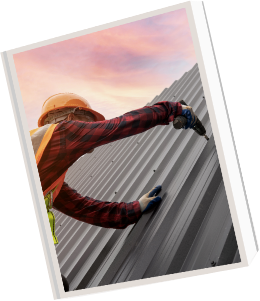What is a Roofing System? (And Why Every Component Matters)
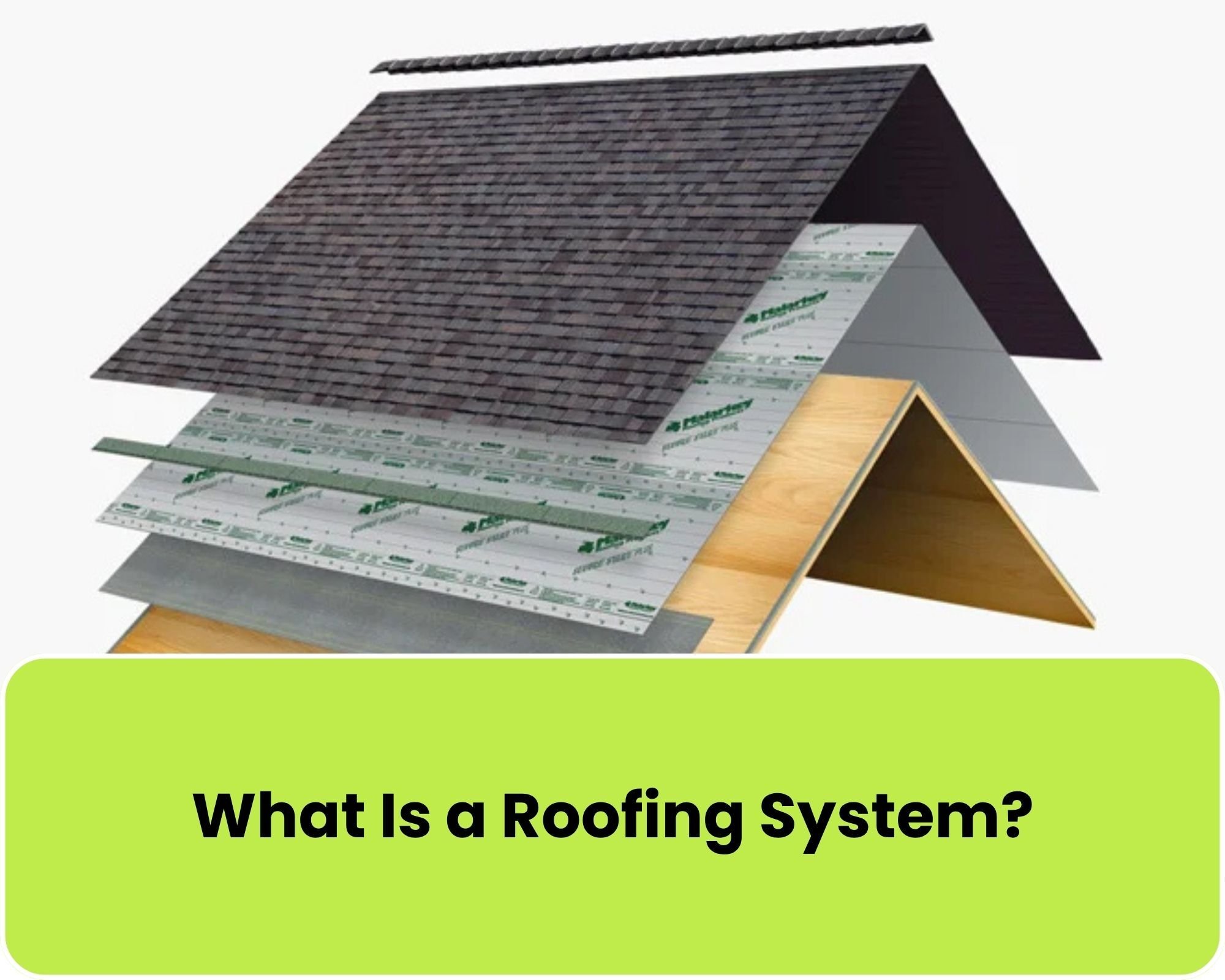
Most homeowners think of their roof as just shingles, but that's only one piece of a much larger puzzle. A true roofing system is made up of several layers and components that all work together to protect your home from water, wind, and temperature extremes. When even one part of that system fails, it can affect everything else.
At Happy Roofing, we've seen countless situations where leaks and premature wear were caused by an underlying problem, hidden underneath the shingles. That's why we emphasize complete roofing systems rather than surface-level replacements or roof overlays.
In this article, we'll break down:
- The core components that make up a modern roofing system
- How these layers work together to protect your home
- The benefits of using compatible roofing components
By the end, you'll understand how a properly built roofing system works as a whole, and why that difference matters when it comes to long-term performance and peace of mind.
Table of Contents
- What Is a Roofing System?
- What Components Make Up a Roofing System?
- Should You Replace the Entire Roofing System?
- What Is the Cost of Replacing a Roofing System?
- Roof Overlays vs. Roof Tear-Offs
What Is a Roofing System?
A roofing system is a collection of layered components that work together to seal, protect, and ventilate your home. Each part has a specific job, and when all of these components are installed correctly, they form a durable barrier against the elements.
This illustration from Malarkey's website shows how these components come together:
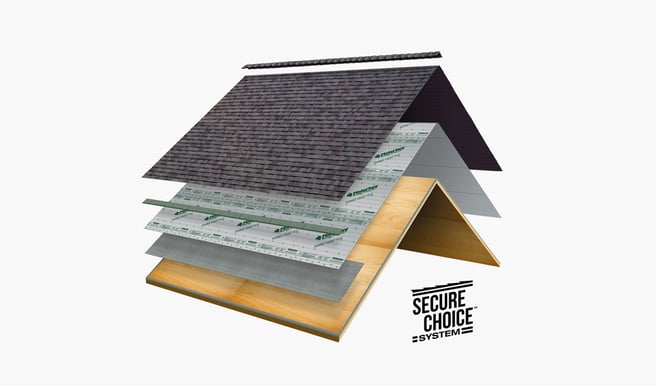
What Components Make Up a Roofing System?
A roof system is made up of underlayment, ice and water shield, decking, shingles, and flashing. These components work together to create a durable, weather-resistant shield over your home.
Roof Decking
Decking (or sheathing) is the foundation that supports the entire roof, often made from plywood or Oriented Strand Board (OSB). Decking provides the structural base for the underlayment and shingles to attach to, ensuring strength and stability across the roof surface. If it becomes warped, rotted, or water-damaged, it can cause shingles to lift, nails to loosen, leaks to form, or even promote mold growth.
Think of roof decking like the foundation under your flooring. Just like carpet or hardwood needs a solid, level subfloor to stay flat and secure, your shingles need strong decking beneath them. If that base is weak or damaged, everything on top is negatively affected.
Below is a photo of roof decking, with the numbers marking the material sheets that we've replaced:
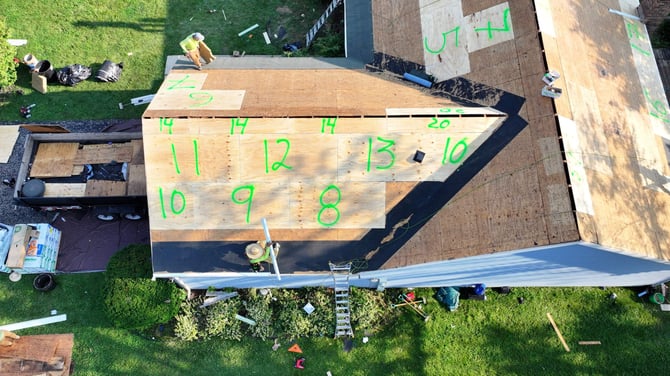
Underlayment
Underlayment is a waterproof barrier installed between the decking and shingles that serves as the roof's secondary defense against leaks. Its job is to prevent moisture from reaching the decking or entering the home, especially during heavy rain or when shingles are damaged.
Your underlayment is like the waterproof mattress protector under fitted sheets. The fitted sheet is meant to take most of the wear, but if something spills, leaks, or soaks through, it's the mattress protector (the underlayment) that saves your mattress (the roof decking) from damage.
It's typically made from either asphalt-saturated felt or synthetic polymer materials. Here are the key differences between felt and synthetic underlayment:
- Felt Underlayment: Made from asphalt-saturated paper, it's the traditional option that offers basic water resistance at a lower cost. However, it's heavier than synthetic underlayment, more prone to tearing during installation, and less durable in extreme heat or prolonged moisture.
- Synthetic Underlayment: Made from woven or spun polymer materials, it's lighter, stronger, and far more resistant to water, UV exposure, and tearing than felt underlayment. It's also easier to handle and is resistant to rotting.
Here is a progress photo showing the synthetic underlayment we use on our roofing projects:
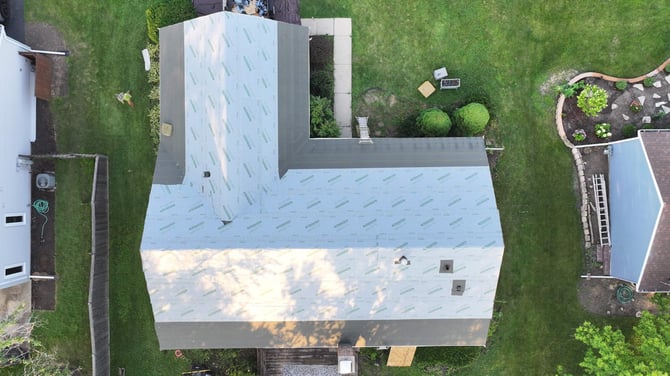
Ice and Water Shield
This is the self-adhering, waterproof membrane installed beneath shingles in vulnerable areas such as roof valleys, eaves, and around penetrations.
It creates a tight seal that prevents water from backing up under shingles due to wind-driven rain, or melting snow and ice (common occurrences in Illinois' freeze-thaw climate). This added layer of protection is especially important along roof edges, where leaks are most likely to start.
Ice and water shield works similarly to underlayment, serving as a defense against water intrusion that's made its way past the shingles. In the photo below, the ice and water shield can be seen mid-installation (the black material along the edges of the roof):
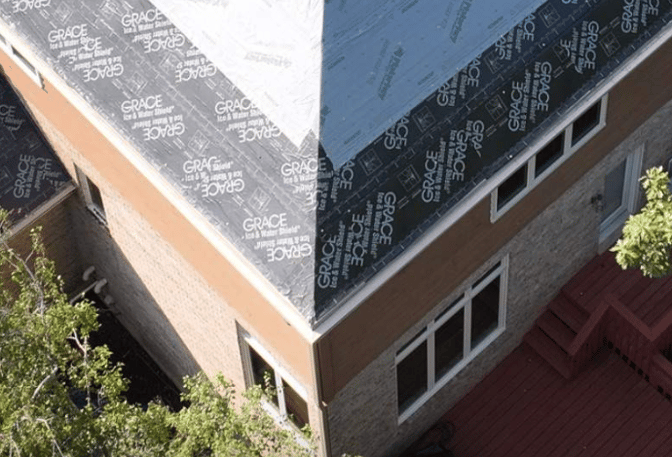
Shingles (or other outermost roofing material)
The visible, outermost layer of the roofing system provides the first line of defense against the elements. For residential applications, this material can be asphalt shingles, metal, cedar shake, synthetic, or tile.
In Illinois, asphalt shingles remain the most common choice due to their affordability and proven performance in varying climates.
Three types of asphalt shingles are used to complete a roof, and each is considered a separate component of the roofing system:
- Starter Shingles: Installed along the roof's edges (eaves and rakes), starter shingles provide a straight, sealed base that helps prevent wind uplift and water intrusion at these vulnerable edges. They feature an extra adhesive strip that bonds tightly with the first row of field shingles, creating a secure seal that keeps wind and water from getting underneath.
- Field Shingles: These make up the majority of the roof surface and are what most people typically think of when they hear the word 'shingle'. Field shingles are installed in overlapping rows to shed water efficiently while providing the roof's primary protection and visual appeal.
- Hip and Ridge Shingles: Installed along the roof's peaks and corners, these specially cut shingles protect the seams where different roof planes meet. They also add a clean, finished look to the roofline while sealing off potential entry points for water.
We've included a finished photo of a roof we completed using asphalt shingles from Malarkey Roofing Products:
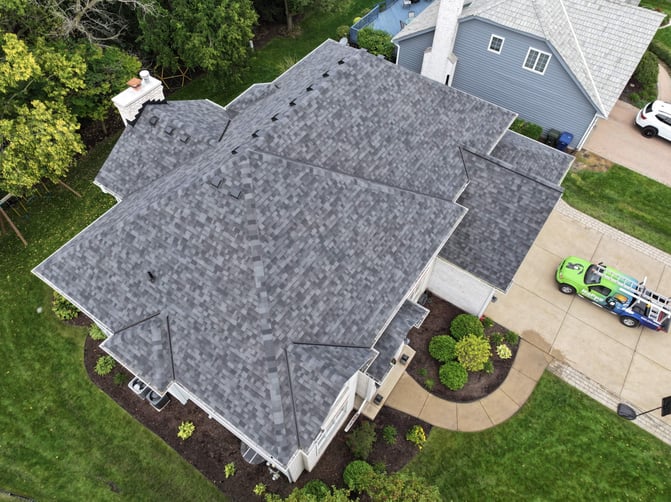
Flashing
Flashing is like the caulk around your bathtub, sealing vulnerable edges and crevices. It's a protective material that seals and directs water away from joints, edges, and roof penetrations such as chimneys, skylights, vents, and plumbing stacks. While flashing is most often made from metal, certain areas may use rubber, PVC, or composite boots designed to create a watertight seal.
Properly installed flashing prevents leaks in the most vulnerable parts of the roof system and is critical to long-term performance. Here is an example of newly installed step flashing:
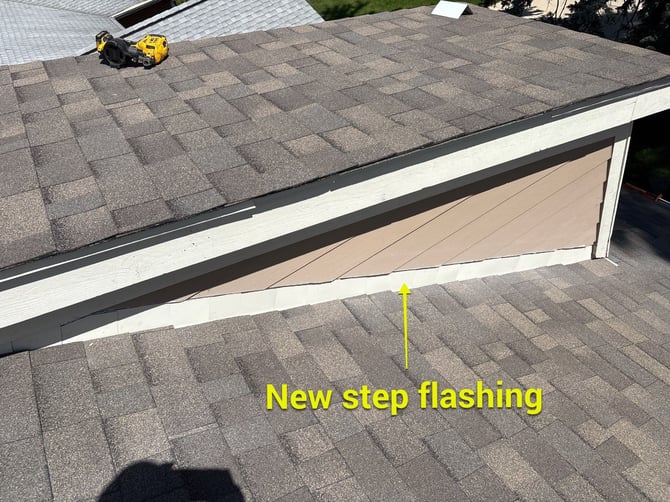
Ventilation
While ventilation itself isn't a physical component of the roof, the vents and systems that make it possible are essential parts of a complete roofing system. Together, they allow air to circulate through the attic, regulating temperature and humidity year-round. Proper ventilation helps prevent heat buildup while reducing moisture that can lead to premature shingle failure.
Intake and exhaust vents work together to keep air moving effectively:
- Intake Vents: Typically installed in the soffits (the underside of the roof's overhang), these vents draw fresh, cooler air into the attic. This airflow pushes warm, moist air upward and out through exhaust vents, maintaining a consistent environment under the roof deck.
- Exhaust Vents: Located near the roof's ridge or upper slope, these vents release hot, humid air from the attic. There are two main types:
- Passive Exhaust Vents: Such as ridge vents or box vents, which rely on natural air movement to ventilate the attic.
- Power Exhaust Vents: Electrically or solar-powered fans that actively pull warm air out, ideal for homes with limited ridge space or higher heat buildup.
Poor ventilation, specifically a lack of intake, is the most common problem we come across during our roof inspections throughout the Naperville area. When it's left unchecked, this lack of airflow can lead to warped and rotted decking, shingle deterioration, mold growth, and increased energy bills.
When balanced correctly, intake and exhaust ventilation form a continuous airflow system that not only extends the roof's lifespan but also improves your home's overall comfort and energy efficiency. Here's a graphic to illustrate how ventilation works:
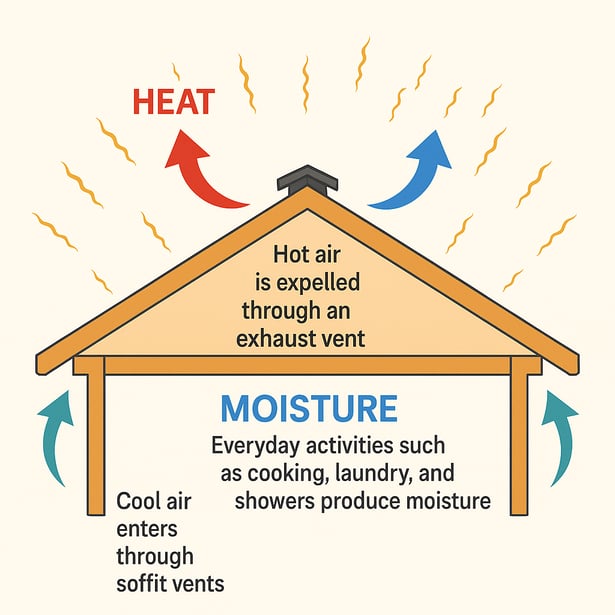
When Replacing A Roof, Should You Replace the Whole Roofing System?
If you need a roof replacement, installing a complete roofing system ensures that all the materials are designed to complement one another, providing full protection and peace of mind for decades.
In many cases, this is a good way to secure stronger warranties and long-term durability, but it isn't always the solution for everyone's roofing needs. Your roofing contractor should assess the health of your roof, and take your long-term goals into consideration before providing you with recommendations.
Here's why a full system replacement may be better for your situation:
- Manufacturer warranties: Most major roofing manufacturers, like GAF and Malarkey, only offer their best warranty coverage when a specified number of system components are installed together (starter, hip, and ridge, and field shingles count as one component) and the roof has proper ventilation. If these pieces aren't used, or if components are mixed from different brands, the warranty could be limited or even voided.
- Better Weather Protection: A full system using materials (or approved materials) from one manufacturer ensures that each layer is engineered to work together and reinforces the others. This layered defense helps prevent leaks, ice dams, wind uplift, and other issues common in Illinois' unpredictable weather.
- Long-Term Value: When only select components of the roof are replaced, the materials age at different rates, which can lead to premature failure or the need for additional repairs. A full system ensures all components work together and age uniformly, giving your roof the best chance to perform reliably for decades. While it might cost a bit more upfront, installing a complete roofing system pays off in fewer repairs, longer lifespan, and stronger warranty protection.
Here is an example from Malarkey's website showing the different levels of warranty coverage and how they're determined by the number of manufacturer-specific roofing accessories installed:
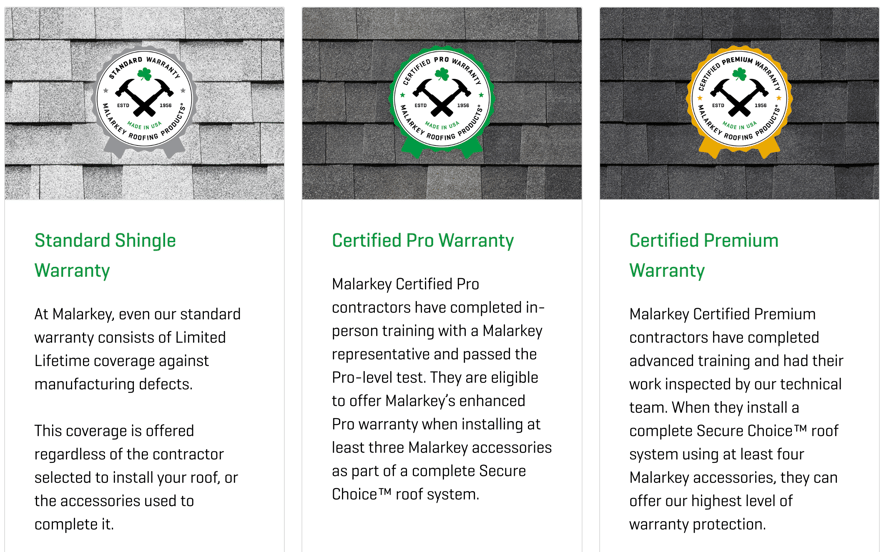
How Much More Does a Complete Roofing System Cost Compared to Just Replacing Shingles?
On average, installing a complete roofing system in the Naperville area costs 10–20% more than a simple roof overlay. That added cost comes from the extra components and labor that it takes to make up the system.
Homeowners who've explored roof replacement options may have heard of a roof overlay (where new shingles are installed over the old ones). When compared to a tear-off (which involves removing all existing materials down to the decking before rebuilding the roof), roof overlays are cheaper, but the cost benefits may not outweigh the drawbacks.
For example, on a typical 2,000-square-foot home:
- Roof overlay: $12,000 – $18,000
- Complete roofing system replacement: $14,000 – $22,000
While that's roughly a $2,000–$4,000 difference upfront, the value extends further than the cost itself. With a complete system replacement from one manufacturer:
- You're getting a fully matched system built to last longer and perform better.
- You're more likely to qualify for extended manufacturer warranties, which can cover materials and labor for decades.
- You'll reduce the need for frequent repairs, especially in Illinois' freeze-thaw climate. This is because your contractor can access every part of the roofing system, correct any issues that may be present (like poor ventilation), and replace all of the existing materials with new, long-lasting components.
A complete roofing system is a smarter long-term investment if you plan on keeping your home for the foreseeable future. While it will cost a bit more upfront, it typically will pay for itself in fewer repairs, stronger warranties, and peace of mind.
Is a Roof Overlay or a Roof Tear-Off Better For Me?
A roof is an entire system of components working quietly to protect your home. While a complete roofing system may cost more upfront than a shingle-only replacement or overlay, it delivers lasting benefits for homeowners who are thinking long-term: fewer repairs, stronger manufacturer warranties, and the confidence that your roof was built to handle Illinois weather for decades to come.
If you're still deciding whether a full roof system replacement is right for your home, read our next article: Roof Replacement Options: Roof Overlay vs. Tear-Off — Pros, Cons, and Costs. In it, we dive deeper into how each approach compares in cost, durability, and long-term performance, so you can make the best decision for your home and budget.
If you'd like to get a professional evaluation of your roof for tailored recommendations, we offer no-commitment inspections to provide you with clear answers. Our goal is to give you insight into the health of your roofing system, without pressuring you into any sales.
The Author: Pedro Toledano
Happy Roofing is a trusted roofing company dedicated to providing top-quality roofing services to residential and commercial clients. With years of experience, they specialize in roof installations, repairs, and maintenance, ensuring durability and customer satisfaction. The team is known for their professional approach, timely service, and attention to detail. Happy Roofing prides itself on using high-quality materials and offering competitive pricing. Follow their Facebook page for updates on projects, customer testimonials, and tips on maintaining your roof in excellent condition.





